ALDER
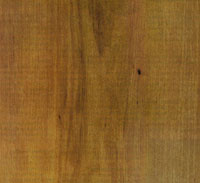 |
Source: |
Pacific Coast (California and north). |
Color: |
Pale pinkish-brown to almost white. |
Pattern: |
Not distinct. |
Characteristics: |
Good working properties; strength
between Red Gum and American tulipwood. |
Uses: |
Unexposed structural parts for furniture;
core stock. |
Availablity: |
Rare as veneer, limited as lumber. |
|
|
Special
Notes: |
|
|
 |
ASH
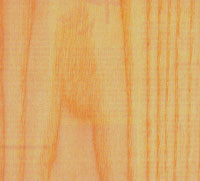 |
Source: |
Eastern USA, Lake States, New England
and Central States |
Color: |
Warm brown heartwood with narrow light
brown sapwood. |
Pattern: |
Straight moderately open grain. |
Characteristics: |
Heavy, hard, strong, stiff and high
shock resistance with excellent blending qualities and
above average workability. |
Uses: |
Interiors, furniture, handles of tools
and implements, sporting and athletic goods. |
Availablity: |
Readily as veneer and lumber. |
|
|
Special
Notes: |
|
|
 |
BIRCH
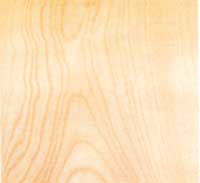 |
Source: |
Canada and the USA (Lake States)Canada
and the USA (Lake States) |
Color: |
Cream or light brown tinged with red,
with thin, nearly white sapwood. |
Pattern: |
Both rotary and sliced, plain and
often curly or wavy. |
Characteristics: |
Heavy, very strong, hard closed-grained,
even texture. |
Uses: |
Furniture, interiors, interior and
exterior doors, store fixtures, accessories. |
Availablity: |
Readily as veneer and lumber. |
|
|
Special
Notes: |
As veneer the sapwood of rotary birch
is sold as "white birch" and the heartwood as "red birch".
The greater volume produced is "natural birch" and contains
a combination of color tones. |
|
 |
CEDAR
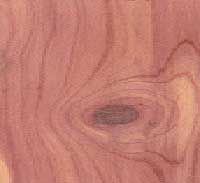 |
Source: |
Eastern USA and Southern Canada |
Color: |
Light red with streaks of creamy white |
Pattern: |
Soft, straight-grained with a fine,
even texture. Very knotty with distinctive cedar aroma. |
Characteristics: |
Soft, easy to work but knots may present
some difficulties. Easy to finish, very distinctive cedar
aroma. |
Uses: |
Linen and blanket chests, pencils,
boxes. |
Availablity: |
Readily as veneer and lumber |
|
|
Special
Notes: |
|
|
 |
CHERRY
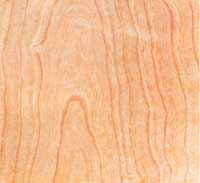
|
Source: |
Maine to Dakotas and Appalachians,
Pennsylvania to West Virginia |
Color: |
Light reddish-brown. |
Pattern: |
Straight-grained, satiny, some figured,
small gum pockets are normal markings. |
Characteristics: |
Light, strong, rather hard, fine-grained |
Uses: |
Fine furniture, woodworker and engravers
blocks |
Availablity: |
Readily as veneer and lumber. |
|
|
Special
Notes: |
|
|
 |
FIR
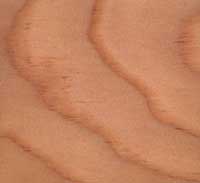
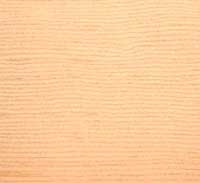 |
Source: |
Pacific Coast North America and Rocky
Mountain states |
Color: |
Heartwood varies with conditions of
growth from pinkish-yellow to reddish-brown; sapwood
lighter. Hem-Fir lumber is lighter and brighter in color,
varying from a creamy, nearly-white to a light, straw-brown
color. |
Pattern: |
Fine grained and even textured, lending
formality to wood paneling, cabinets and trim. |
Characteristics: |
Dense, hard, stiff, durable, strong. |
Uses: |
Douglas Fir: Heavy duty construction
such as wharves, trestles, bridge parts and commercial
buildings. Hem-Fir: Solid wood doors, louvers, shutters,
moulding, case goods, furniture. |
Availablity: |
Readily as veneer and lumber. |
|
|
Special
Notes: |
|
|
 |
HICKORY
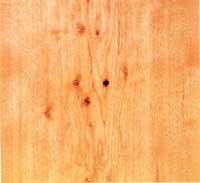 |
Source: |
Northeastern Canada and USA to Southwest
into Mexico |
Color: |
White to cream with inconspicuous
fine brown lines and tan heartwood. |
Pattern: |
Hickory is a ring porous woods, meaning
that the pores of the spring wood form a well-defined
ring. |
Characteristics: |
Extremely tough and resilient, quite
hard and only moderately heavy. |
Uses: |
As veneers -furniture, skis and moulding
and bent plywood requiring extreme strength. |
Availablity: |
|
|
|
Special
Notes: |
Readily as veneer and lumber. |
|
 |
MAHOGANY,
AFRICAN
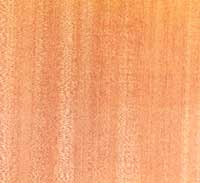
|
Source: |
Africa (Ivory Coast, Gold Coast, French
Cameroon, Cape Lopez, Nigeria) |
Color: |
Light pink to reddish-brown and tannish-brown |
Pattern: |
Although pores are distributed, this
wood produces a very distinct, pleasing grain. The most
lavish figured mahogany offered in plain stripe, broken
stripe, mottle, fiddleback, fine crotches and faux swirl. |
Characteristics: |
Available in great lengths and widths,
milder textured with slightly larger pores than other
Mahogany species, relatively hard, works well, lightly
lustrous, polishes well, durable. |
Uses: |
Interior furniture, accessories and
art objects, boats |
Availablity: |
Readily as veneer and lumber. |
|
|
Special
Notes: |
|
|
 |
MAHOGANY,
SOUTH AMERICA
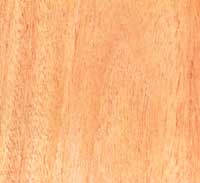 |
Source: |
Peru, Brazil, Central America (Honduras,
Guatemalan, Nicaragua), Mexico, Jamaica |
Color: |
Varies from light reddish or yellowish-brown
to rich, dark red, depending upon the country of origin.
Mostly yellowish-tan. |
Pattern: |
A considerable variety of figures,
similar to African Mahogany except crotches are not readily
available. Straighter grain usually. |
Characteristics: |
Lighter and softer than Cuban, extremely
good strength properties, works well, stains and varnishes
well, durable and decay-resistant. Central America produces
more figured logs for fancy veneers. |
Uses: |
Furniture, paneling, fine joinery,
boats, ships, pattern-making, exterior uses. |
Availablity: |
Readily as veneer and lumber. |
|
|
Special
Notes: |
|
|
 |
MAPLE, HARD
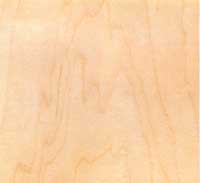 |
Source: |
USA (Lake States), Appalachians, Northwest
USA, Canada |
Color: |
Cream to light reddish-brown heartwood,
thin white sapwood tinged slightly with reddish-brown. |
Pattern: |
Usually straight-grained, sometimes
found highly figured with curly, fiddleback, blistered,
quilted, Birds Eye or burl grain, scattered over entire
tree or in irregular stripes and patches. |
Characteristics: |
Heavy, hard, strong, close-grained,
tough, stiff, uniform texture. Excellent resistance to
abrasion and indentation. |
Uses: |
Furniture, interiors, fixtures, flooring,
woodenware, cutting surfaces, bakery paddles and other
industrial uses, school furniture, decorative inlays
and overlays. |
Availablity: |
Plain Maple -readily as veneer, Figured
Maple limited as veneer. Readily as lumber. |
|
|
Special
Notes: |
|
|
 |
MAPLE, SOFT
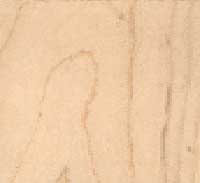 |
Source: |
USA (Lake States), Appalachians, Northwest
USA, Canada |
Color: |
Cream to light reddish-brown heartwood,
thin white sapwood tinged slightly with reddish-brown. |
Pattern: |
Usually straight-grained, sometimes
found highly figured with curly, fiddleback, blistered,
quilted, Birds Eye or burl grain, scattered over entire
tree or in irregular stripes and patches. |
Characteristics: |
The soft maples are roughly 25 percent
softer than the hard maples. Heavy, fairly hard, fairly
strong, close-grained, stiff, uniform texture. Good resistance
to abrasion and indentation, however Hard Maple is stronger
and more resistant. |
Uses: |
It is hard to believe, but the same
species used for bowling alleys can also be sliced into
gorgeous veneers and made into priceless musical instruments. |
Availablity: |
Readily as veneer and lumber. |
|
|
Special
Notes: |
|
|
 |
OAK, RED
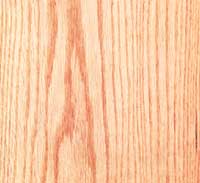 |
Source: |
USA (especially Appalachians), Ohio,
Kentucky |
Color: |
Slightly redder tinge then While Oak
although difficult for an untrained eye to tell the difference. |
Pattern: |
Flake figure less prominent than white
oak's. |
Characteristics: |
Slightly courser grain, with large,
rounded, open pores. A little easier to finish than white
oak., though both are excellent. |
Uses: |
Nearly all common uses of hardwoods,
and especially popular where strength and durability
are required. Not for water-tight or water-resistant
purposes, were white oak is the choice. |
Availablity: |
Readily as veneer and lumber. |
|
|
Special
Notes: |
Except for source and color, Red Oak
and White Oak, the two leading American species, are
very similar. Quarter sliced and sawn oak has an attractive
figure of stripes and leafy grain caused by the distinct
layers of springwood and summerwood and the large pores,
especially concentrated in springwood. Rift-cut oak has
a fine pinstripe. Rotary cut oak has a distinctive watery
figure with great contract. |
|
 |
OAK, WHITE
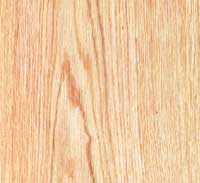 |
Source: |
Eastern USA (especially Central States)
and through Appalachian region |
Color: |
From light brown with a greyish tinge
in the heartwood to shades of ochre in the sapwood. |
Pattern: |
More pronounced and longer rays than
red oak, and more frequently rift-sawn for the comb-grain,
pin striped figure than red oak. |
Characteristics: |
Pores are angular and very numerous
and filled with glistening substrate called tyloses,
which makes this wood especially suitable for water-tight
containers (barrel staves) and where water resistance
is required. Tannic acid in the wood protects it from
fungi and insects. Closer grain than red oak. |
Uses: |
Nearly all common uses of hardwoods,
and especially popular where strength and durability
are required. Also for water-tight or water-resistant
purposes. |
Availablity: |
Readily as veneer and lumber. |
|
|
Special
Notes: |
Except for source and color, Red Oak
and White Oak, the two leading American species, are
very similar. Quarter sliced and sawn oak has an attractive
figure of stripes and leafy grain caused by the distinct
layers of springwood and summerwood and the large pores,
especially concentrated in springwood. Rift-cut oak has
a fine pinstripe. Rotary cut oak has a distinctive watery
figure with great contract. |
|
 |
PINE, KNOTTY
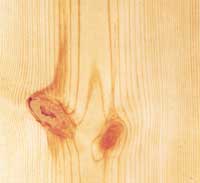 |
Source: |
Western - Pacific Northwest, Eastern
- Eastern USA and North |
Color: |
Cream color to light reddish-brown
with yellowish-white sapwood. |
Pattern: |
Knotty |
Characteristics: |
Softwood but occasionally used as
cabinet wood. Light, soft, not strong, close, straight-grained. |
Uses: |
Used in construction and interior
finishing of buildings, lumber and veneer for furniture. |
Availablity: |
Readily available as veneer or lumber. |
|
|
Special
Notes: |
|
|
 |
POPLAR
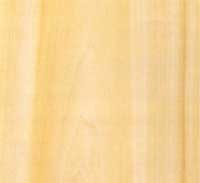 |
Source: |
Eastern USA |
Color: |
White to yellowish cast, sometimes
with slight greenish cast, and occasionally with rather
dark streaks. |
Pattern: |
Straight grain. |
Characteristics: |
Even texture, light to medium weight,
excellent strength, machines easily, stable when dried,
excellent gluing and resilience to splitting when nailed. |
Uses: |
As veneer for faces, cross-banding,
and backs for plywood. As lumber for furniture component
parts, turnery, interior trim and millwork, cabinetry,
and exterior trim and siding. |
Availablity: |
Readily available as veneer or lumber. |
|
|
Special
Notes: |
|
|
 |
WALNUT
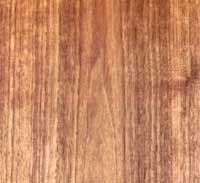
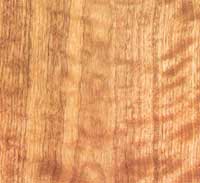 |
Source: |
Walnut grows throughout the United
States and southern Canada, however, its commercial range
is confined largely to the Central States. |
Color: |
Light grey-brown to dark purplish-brown. |
Pattern: |
Plain to highly figured. This one
species produces a greater variety of figure types than
any other, approached only by mahogany. Longwood (plain
and quarter sliced, half-round, both plain and figured,
crotches, swirls, stump wood and occasional burls). |
Characteristics: |
Moderately heavy, very strong for
its weight, exceptionally stable. |
Uses: |
Furniture, architecturally woodwork,
gunstocks, novelties. |
Availablity: |
Readily as veneer and lumber. |
|
|
Special
Notes: |
|
|


















